
views
- Drink 1 glass of water every hour up until your run so you're hydrated.
- Eat something simple 2-3 hours before your run, like a peanut butter and jelly sandwich.
- Wear light, breathable clothing. Synthetic athletic fabrics work best since they don't trap sweat.
- Jog at 40-50% your normal speed for 5-10 minutes to warm up.
Preparing to Jog

Hydrate throughout the day. Your body needs time to store the water, and trying to chug a water bottle right before you leave is ineffective and uncomfortable. Aim to drink one glass of water every hour up until you set out on your run. You need to drink water to stay hydrated and energized. Aim for 8-16oz of water 1-2 hours before running.
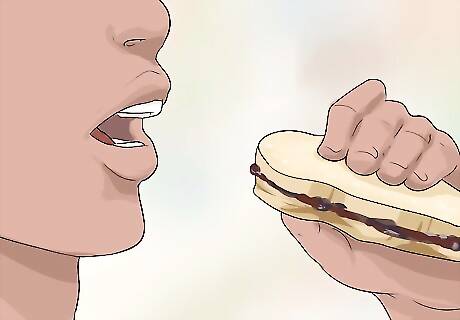
Eat a simple meal 2-3 hours before you plan on running. You don't need to eat a lot unless you plan on running more than 12-13 miles. A bagel with honey or jam, a granola bar and fruit, or a peanut butter and jelly sandwich will provide fuel that your body can digest quickly. Avoid slow to digest foods like thick pasta sauces, fried foods, or cheeses. Aim for a simple combination of carbohydrates (bagel, toast, granola, oatmeal), natural sugar (jelly, banana, apple, honey), and protein (peanut butter, yogurt, grilled chicken).

Set a reasonable goal. This is especially important if you are just beginning to run regularly. Use a map or a running specific app, like MapMyRun, to plan out a route that works for you. A good start for your first few weeks is 20-30 minutes, running 2-3 miles at a time. As you progress, listen to your body -- if your muscles and joints are hurting after every run, slow down and do less mileage until you are better prepared.
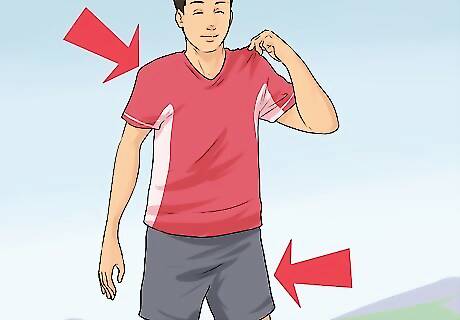
Dress to exercise. You should wear light, breathable clothing that doesn't trap sweat. If you are going for a short run, then a cotton shirt will be fine, but you should use synthetic athletic wear for longer runs. Your body will raise it's temperature by 10-15 degrees, so dress as if the weather is 10-15 degrees warmer.

Buy running shoes. Make sure your sneakers fit by trying them out on short runs. If you get any blisters or feel numbness in your toes, you need better-fitting shoes. Your heel should stay snugly in the shoe. You should have room to wiggle your toes. The balls and arches of your feet should be comfortable but not tight. There is a growing movement to run barefoot for it's supposed health benefits, but only try it if you are sure you will not step on anything dangerous.
Preparing for a Race or Long Run

Taper your exercise schedule a week before the race. Tapering is when you ease off your workouts before the race, allowing your muscles plenty of time to recover. Make your runs shorter and slower, and switch to other activities you do regularly like biking or swimming (nothing new) 2-3 days before the race to rest your running-specific muscles. Resist the urge to train hard at the last minute -- it will make you less effective when race day arrives It takes upwards of 6 weeks for you body to benefit from hard training, so a hard workout two days before the race won't help you. Marathon runners often begin tapering 3-4 weeks before a race, lowering their training mileage by 10 miles each week. Either rest completely or take it very slow the day before the race.

Monitor your diet at least three days before the race. Your body needs the right fuel to be effective, and eating junk food even 2-3 days before the race can make you feel sluggish. Avoid rich and fatty foods like donuts or bacon at least three days before race time and try to eat more carbohydrates (pasta, bread, etc) to prepare. Your body has the ability to store almost 2,000 calories in carbohydrates, and you'll need them to run effectively. Day 1: Eat lots of complex carbs -- starchy foods like whole wheat pasta and bread, oatmeal, and quinoa. This allows your body to digest fully a few days in advance. Day 2: Begin switching to simple carbs like fruits, pasta, and white bread. Cut any junk food from your diet now. Day 3: Keep eating simple carbohydrates, like a big plate of pasta with marinara sauce. Try to eat your last big meal 12-15 hours before the race. Try this diet out a few days before a training day to see how your body feels with different foods.

Sleep at least 8 hours the night before the race. Resting gives your muscles energy to move longer and faster. Try to get a normal night's sleep -- you don't want to sleep for 12 hours and wake up feeling sluggish.

Hydrate, hydrate, hydrate. The importance of hydration cannot be stressed enough, not only for performance but for your health and safety. You should be drinking 4-8 ounces of water every hour at least two days before the race, along with foods rich in electrolytes (bananas and pretzels are great). A few hours before the race, drink 16oz of water to prepare. Do not "over drink" by chugging right before the race -- your body won't have time to absorb it and you will feel bloated.

Eat a simple, low-fiber breakfast the day of the race. You want food that will pass through your body quickly but still provide you energy. Toast with jam or peanut butter, oatmeal with some fruit, or granola and yogurt will all provide you lasting energy without weighing you down. Try to eat 2-3 hours before the race.

Dress lightly. Your body will raise it's temperature by 10-15 degrees, so dress as if the weather is 10-15 degrees warmer. Overdressing can lead to heat exhaustion and dehydration from over-sweating.
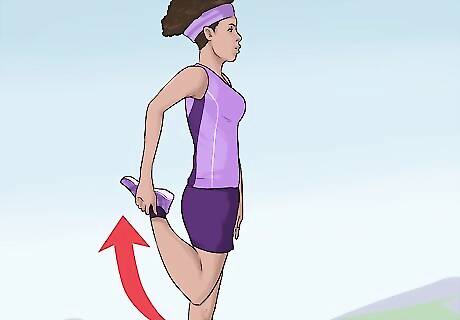
Warm-up properly with a dynamic workout. Some studies have shown the the classic "stretch and hold" warm-up, when done alone, can actually decrease performance. You should mix light stretching with a "dynamic stretch," which is a small exercise meant to get your blood flowing and your muscles loose. Jog lightly for 10-15 minutes, gradually increasing pace. Lightly stretch each muscle, holding for no more than 10 seconds each. Slowly jog for another 10 minutes. Mix in 3-5 lunges, squats, skips, and jumps to warm up specific muscles.
Warming Up Effectively
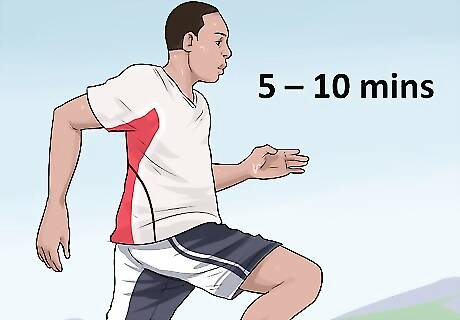
Jog for 5-10 minutes. No matter how long you are running, you never want to start at your fastest pace. You muscles need time to warm up and gain elasticity to be effective and avoid injury. Start at a pace roughly 40-50% your running speed to begin your warm-up.
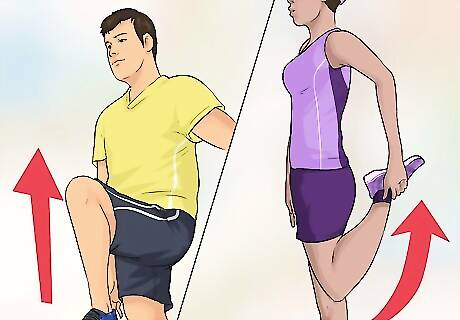
Mix high knees, butt kicks, and shuffling into your warm-up run. These are exaggerated runs that warm up specific muscles and help your legs prepare for a full range of motion. Do each of these "dynamic stretches" for at least a minute, or try skipping as well. High Knees: With every step, lift each knee up to hip height. Butt Kicks: Exaggerate lifting your back leg so your heel comes up and taps your buttocks. Shuffle Step: Turn sideways and move horizontally for 3-4 steps. Pivot on your front foot and face the other direction, shuffling for 3-4 steps before alternating again.
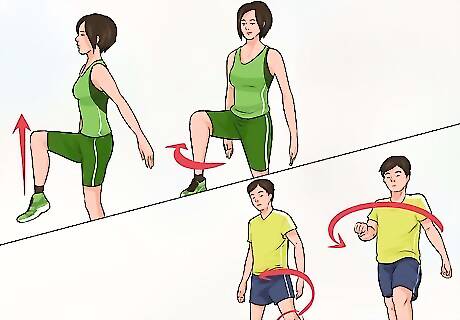
Warm up you hip muscles. These often forgotten muscles need to be loose for a smooth running motion. Take some time to do "hip openers and closers" to get ready. Hip Openers: Walking laterally (side to side), lift your front knee up to hip height and then slowly arc it out to the side, turning you the other direction. Repeat with the other foot. Hip Closers: Walking laterally, pick up your back leg and arc it in front of your body. Pivot on your balancing foot so that you face the other direction and repeat.
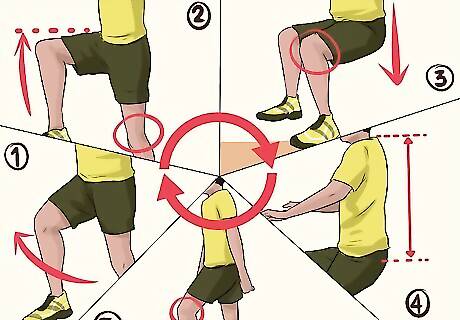
Do lunges to prepare your quads and glutes. Your thighs and butt muscles are essential for running, especially up hill. Get them firing with some lunges: Step forward with one foot, bending 90 degrees at the knee. Rest on the toes of your back foot. Drop your hips down towards the ground, keeping your front knee bent at 90. Keep your back straight as your drop. Pick up your back foot and step forward with it, repeating on the other side of your body. Repeat 10-15 times on each side.

Bend and flex to warm up joints and tendons. Exhaling as you bend, bend with a curved back and reach for the ground. Return to standing position and then bend backward, thrusting your stomach out. Perform several twists to either side, turning from your hips, and then bend sideways each way while keeping your feet in place. These stretches loosen muscles and joints in your spine to prepare it for running.

Avoid vigorous static stretching. Static stretching is the classic "grab and hold for 10 seconds" stretch. Many studies show that static stretching can actually decrease by performance by tearing muscle fibers. After warming up, limit yourself to a few light 10-15 second stretches on any muscles that are still sore. A stretch should never hurt -- so don't push yourself thinking that you are getting a "better" stretch.




















Comments
0 comment